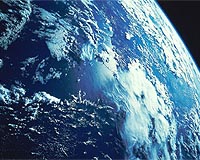 |
London, UK (SPX) Jun 16, 2009 A novel bacterium that has been trapped more than three kilometres under glacial ice in Greenland for over 120 000 years, may hold clues as to what life forms might exist on other planets. Dr Jennifer Loveland-Curtze and a team of scientists from Pennsylvania State University report finding the novel microbe, which they have called Herminiimonas glaciei, in the current issue of the International Journal of Systematic and Evolutionary Microbiology. The team showed great patience in coaxing the dormant microbe back to life; first incubating their samples at 2 degrees C for seven months and then at 5 degrees C for a further four and a half months, after which colonies of very small purple-brown bacteria were seen. H. glaciei is small even by bacterial standards - it is 10 to 50 times smaller than E. coli. Its small size probably helped it to survive in the liquid veins among ice crystals and the thin liquid film on their surfaces. Small cell size is considered to be advantageous for more efficient nutrient uptake, protection against predators and occupation of micro-niches and it has been shown that ultramicrobacteria are dominant in many soil and marine environments. Most life on our planet has always consisted of microorganisms, so it is reasonable to consider that this might be true on other planets as well. Studying microorganisms living under extreme conditions on Earth may provide insight into what sorts of life forms could survive elsewhere in the solar system. "These extremely cold environments are the best analogues of possible extraterrestrial habitats", said Dr Loveland-Curtze, "The exceptionally low temperatures can preserve cells and nucleic acids for even millions of years. H. glaciei is one of just a handful of officially described ultra-small species and the only one so far from the Greenland ice sheet; studying these bacteria can provide insights into how cells can survive and even grow under extremely harsh conditions, such as temperatures down to -56 degrees C, little oxygen, low nutrients, high pressure and limited space." "H. glaciei isn't a pathogen and is not harmful to humans", Dr Loveland-Curtze added, "but it can pass through a 0.2 micron filter, which is the filter pore size commonly used in sterilization of fluids in laboratories and hospitals. If there are other ultra-small bacteria that are pathogens, then they could be present in solutions presumed to be sterile. In a clear solution very tiny cells might grow but not create the density sufficient to make the solution cloudy". Share This Article With Planet Earth
Related Links Society for General Microbiology Life Beyond Earth Lands Beyond Beyond - extra solar planets - news and science
 Caltech Scientists Predict Greater Longevity For Planets With Life
Caltech Scientists Predict Greater Longevity For Planets With LifePasadena CA (SPX) Jun 15, 2009 Roughly a billion years from now, the ever-increasing radiation from the sun will have heated Earth into inhabitability; the carbon dioxide in the atmosphere that serves as food for plant life will disappear, pulled out by the weathering of rocks; the oceans will evaporate; and all living things will disappear. Or maybe not quite so soon, say researchers from the California Institute of ... read more |
|
| The content herein, unless otherwise known to be public domain, are Copyright 1995-2009 - SpaceDaily. AFP and UPI Wire Stories are copyright Agence France-Presse and United Press International. ESA Portal Reports are copyright European Space Agency. All NASA sourced material is public domain. Additional copyrights may apply in whole or part to other bona fide parties. Advertising does not imply endorsement,agreement or approval of any opinions, statements or information provided by SpaceDaily on any Web page published or hosted by SpaceDaily. Privacy Statement |